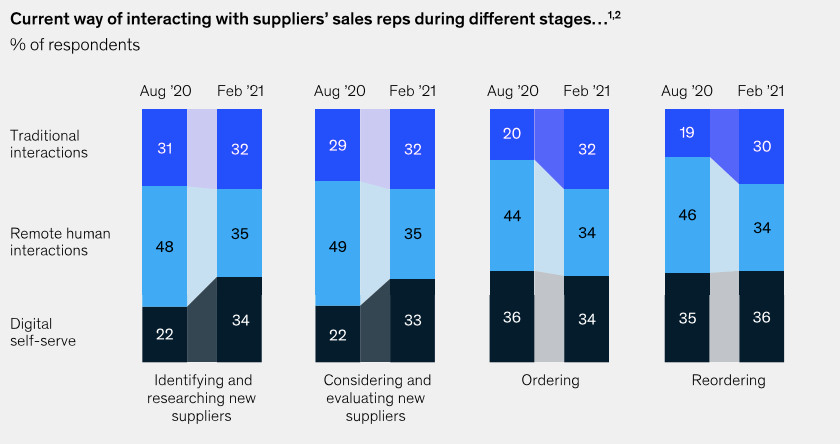Tips for B2B digital commerce now
March 17, 2021Optimize everything and pull from B2C strategies
The new world of digital commerce is disrupting the way B2B companies conduct sales and marketing activities.
B2B marketing efforts are geared towards business entities or organizations where the path to purchase is often complex, involving multiple decision-makers, and buying committees. The decisions made are often need-based and impersonal, taking place after exhaustive research to find the best solution. And generally, both the price points and the stakes are high. Big purchases tended to happen in-person, and online sales were uncommon.
This is in stark contrast with B2C marketing where it’s more emotion-driven and targeted towards individual buyers. The path to purchase is usually shorter, leveraging an individual’s preference for a brand, and to a certain extent, their impulse to buy. Online purchases have been common practice for years and increasing in popularity with each new generation.
However, the pandemic accelerated the need to move to digital commerce for B2B organizations. Research from McKinsey shows that two-thirds of buyers prefer remote human interactions or digital self-service to in-person. And, omnichannel or cross-channel engagement has become the norm, not the exception these days.
This rapid shift to digital commerce has left many B2B marketers searching for the best methods to engage buyers. Here are a few tips to start you on the right path:
Strategies of best-in-class B2B marketing teams
Gone are the days where B2B sales reps visit company offices and attend trade shows, armed with product leaflets and brochures. Instead, best-in-class B2B companies are taking a page out of B2C playbooks and engaging buyers across all touchpoints.
1) Fully-functioning e-commerce websites
Having an e-commerce website is one of the main ways to engage B2B buyers. Forrester calls it “your B2B shop window.” It’s an essential channel where prospects can find information about the products and solutions offered, contact customer services, and complete purchases or other transactions. The browsing experience should be responsive and easy to navigate to support any activity. A mobile-friendly web design and functionalities is also a must-have.
And the clincher a.k.a. checkout should be seamless and frictionless so that buyers don’t get frustrated and abandon the purchasing process half-way.
2) Digital content
Purposeful and compelling content is not restricted to websites. Digital content encompasses everything you might need to help sell or promote your product. It includes blogs, social media, press releases, infographics, videos, and other online media.
Your content should be tailored around educating prospects about your products, showing them how your products can solve their problems, and demonstrating your expertise. This content is used to generate leads (sales inquiries) and then facilitate conversions. Provide everything a buyer needs to make a decision digitally as even purchases as high as $500K and above are even made online now.
3) Social media
Social media should be part of your marketing strategies. Yes, even in B2B. But first, research which platforms your buyers are using. Not all platforms are suitable for your business and focus is important. Otherwise, you waste valuable time and resources on platforms that aren’t relevant to your buyers.
A few years ago, social media for B2B may not have generated leads or been effective in branding campaigns. However, when used correctly, social media will support lead generation tactics, solidify your brand presence, and may even swing on-the-fence customers to your favor. Platforms are constantly evolving with in-app purchases functionality or QR codes to enable sales. Test different types of content on social media and always evaluate results. There is always room to optimize and improve.
4) Product information management (PIM)
Employing the strategies mentioned above would be for naught if your product information is disorganized, not user-friendly, or contains outdated data. You need to leverage a foundational piece of technology to act as a central hub to manage the product data, content, and e-commerce elements.
Manual processes won’t scale anymore.
For example, if a product’s price has been changed and the new price is only reflected on the checkout page (but not on the Instagram page where a prospect first views it), there is a disconnect. With inaccurate product information on any channel, you risk losing buyer trust along with it, the sale.
Being able to manage, organize, and contextualize online product information at scale should be a priority. Its impact on your brand presence is further amplified with the distribution capability across online channels, like your websites, retailers’ sites, marketplaces, and social media.
This is where PIM for B2B comes in to handle these needs. What’s more — it ensures a consistent product experience throughout all touchpoints. The omnichannel journey needs to include accurate and localized product information. This strengthens brand messaging and customer loyalty, which are keys to success.
Digital commerce is here to stay
Forrester reported that U.S. B2B e-commerce is expected to reach $1.8 trillion by 2023, accounting for 17% of all B2B sales in the country. Further, 73% of millennials are involved in the B2B buying process. As digital natives, they embrace self-service and expect it in their personal lives and in business. So, make sure you are prepared.
B2B teams don’t need to struggle to sell online today. Use these tips to start or improve your e-commerce and online marketing strategies. Leverage marketing best practices and include foundational technology platforms like a PIM to act as a hub for all product information and e-commerce elements. Then, build from there.
Remember, B2B buyers want the same frictionless buying experiences B2C buyers have. Connect the website and all experiences across channels and you have a solid foundation.
author
Erika Goldwater, CIPP
Director of Global Communications
Erika Goldwater is the director of global communications for inriver. An industry veteran, Erika lives and breathes B2B marketing, content, public relations, and data privacy. She's a Boston marketer who hails from Baltimore.
Read more

